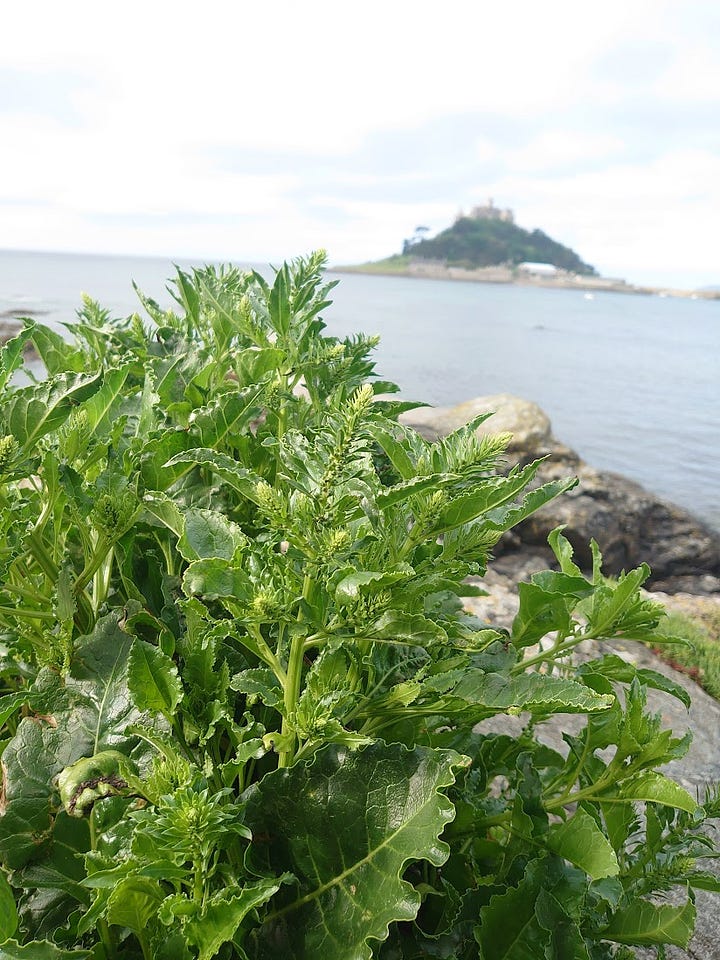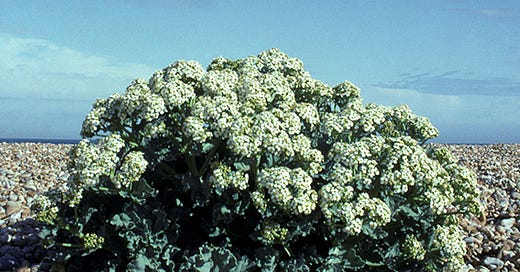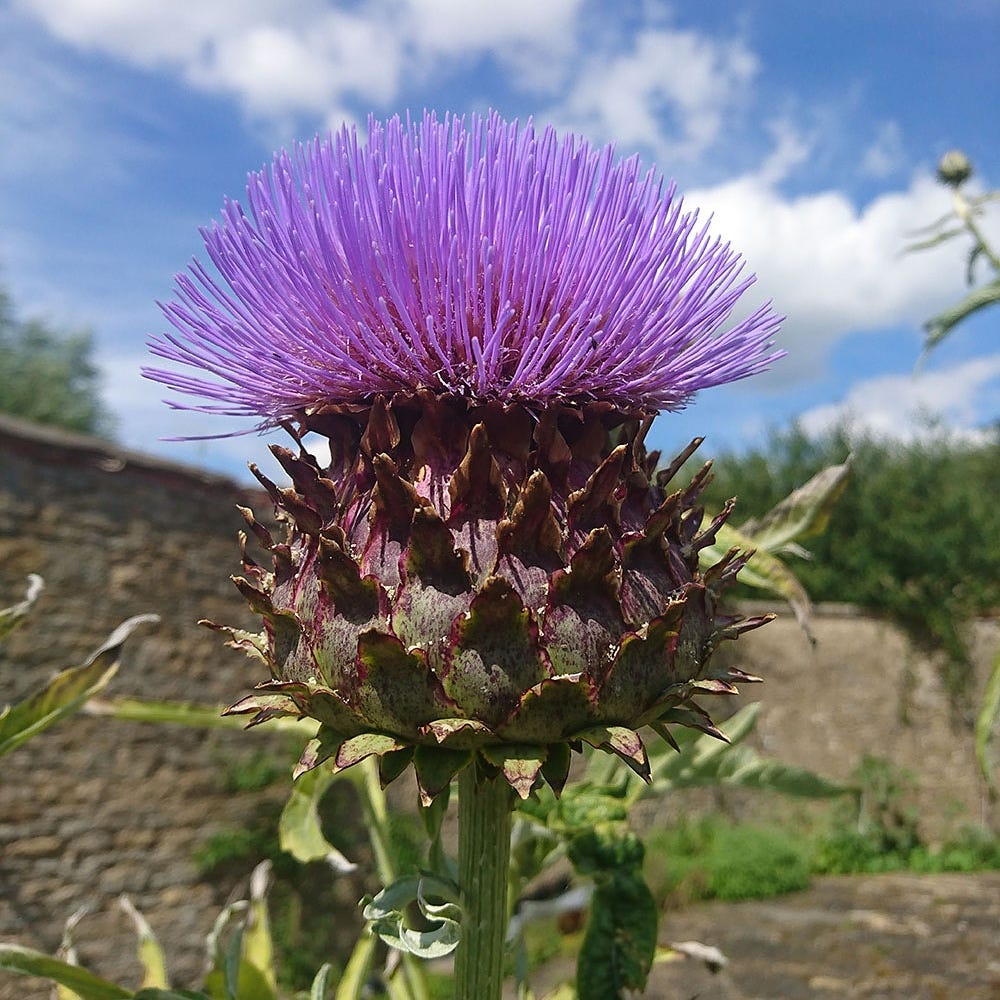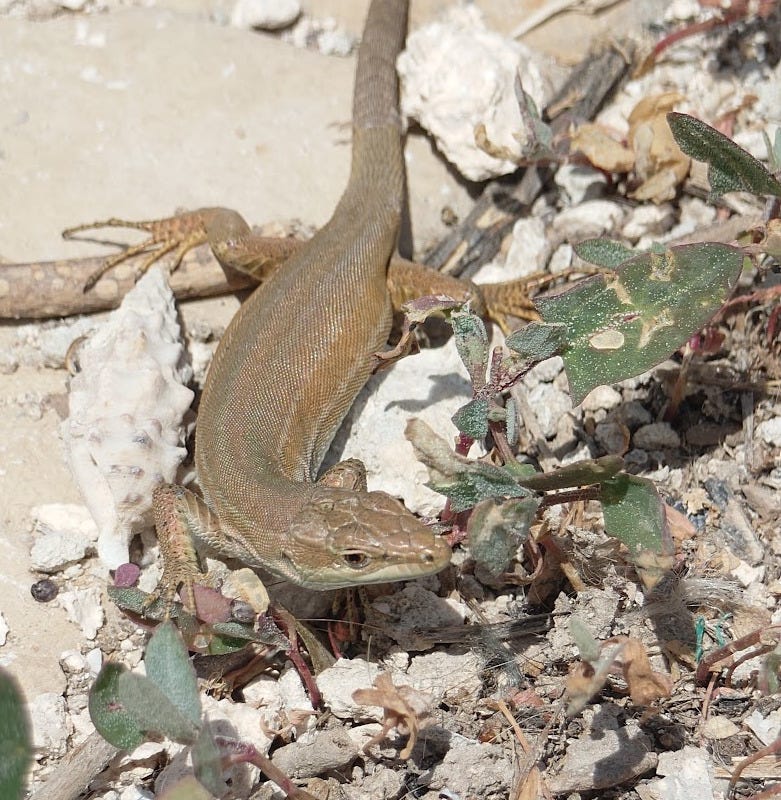Some climate-resilient edibles from the coast
As climate change increases the risk of coastal flooding, interest is growing in salt tolerant crops. I look at some of the salt tolerant edibles you can grow in your garden.
🌱 I'm Sally Morgan, an organic gardener and botanist who loves to experiment. Here you can read about matters relating to climate change, sustainability, organic gardening, growing veg and biodiversity, helping you to become a
climate savvy gardener 🌱☀️🌧️❄️🌡️
I have a little nook in my kitchen garden where I can sit, listen and watch. It’s near the dipping pond which is busy with dragonflies at the moment. And this week, sitting and watching is particularly pleasurable as I can enjoy the masses of white flowers and the divine honeyed scent of my sea kale. Not surprisingly, it’s buzzing with bees too. Sea kale is an edible plant, but much I as enjoy eating the young shoots, I’m loathe to take many as I want lots of flowers, so I really need to grow more.
As an ecologist, I love exploring salt marshes and shingle banks where conditions are truly extreme for plant and animal alike. It’s here that you find the group of plants known as halophytes: sea kale, sea plantain, sea beet, yellow-horned poppy, sea lavender, sea pea, sea campion and other plants that can cope with the high levels of salt.
Living in a salt water environment, they are adapted to a physiological drought – just as in The Ancient Mariner “Water, water every where, Nor any a drop to drink”. They have all sorts of adaptations to enable them to survive this hostile environment, especially their leaves that can be thick, succulent, inrolled, small or waxy to reduce the loss of water through transpiration and store as much as possible. Some have salt glands to get rid of excess salt.

To me they are the ultimate climate-resilient plant. Looking around my garden at the end of the 2022 heat wave, my drought-tolerant plants had done well, but the winners were my halophytes. My sea kale and sea beets didn’t get watered and they thrived.
Last week at Chelsea, I noticed that there were quite a few gardens that featured coastal planting schemes. I highlighted Nigel Dunnett’s Hospitalfield Arts Garden and the fabulous Seawilding garden which featured seagrass in a saltwater tank in my last post. There was a coastal vibe on the Navium Marine Blue Mind Garden’s balcony with planting designed as a retreat for a couple living in a town near the coast, and the Addleshaw and Goddard ‘Freedom to Flourish’ small garden designed by the Carey Garden Design Studio which reflected the wild landscape of the Norfolk coast.

Edible halophytes
We already grow a number of halophytes in our gardens, amongst the best known being the sea hollies (Eryngium sp.) and cardoons (Cynara cardunculus) and there are lots of others – a clue is the reference to ‘sea’ in the common name and maritima in the Latin.
In the Mediterranean, edible halophytes are very popular and appear in markets and on menus, while we see just the occasional samphire on the fish counter. Halophytes are known for their bioactive compounds, especially phenolics and flavonoids, which makes them healthy options, and we need to grow more of them.




Here are a few edible drought-tolerant halophytes that you could grow in the garden:
Sea kale (Crambe maritima) has to be top of my list, being both ornamental and edible. It’s a relative of the cabbage and has fleshy grey-green leaves and a mass of white flowers in late spring. It likes a sunny position with free draining soil. It can just about cope with my clay but its marginal! It’s the young shoots that are harvested and they are a bit like asparagus. Some people blanch the shoots by placing plants in a dark place over winter or under a rhubarb forcer, but its not necessary.
Sea beet or sea spinach (Beta vulgaris subsp. maritima) is a truly resilient plant and quite a thug so beware if you decide to grow this edible. The leaves look like a glossy spinach and are picked in the same way. It’s rich in vitamin C and was reportedly picked by sailors to prevent scurvy. It has a scrambling growth habit so will cover a large area quite quickly. I don’t allow it to flower as seedlings appear everywhere, and they can cross pollinate with chard and spinach. And I suspect its quite allelopathic too, as I can’t grow much near it.
Cardoon (Cynara cardunculus) is a tall perennial with large silver-grey spiny leaves. Mine grow to several metres in height and take up a lot of space, and I find they are prone to collapse. The purple thistle like flowers are wonderful, that’s if the squirrels don’t eat the flower buds first. You eat the stalks. Riverford has a field of cardoons in Devon, and the stems often appear in their veg boxes but they are not very popular…
Summer purslane (Portulaca oleracea) has a small, fleshy, edible leaf and is said to be the best source for omega-3. Being half hardy, I grow it from seed each year and it copes well with heat and drought.
Saltbush (Atriplex halimus) is a drought tolerant shrub that grows to 2m in height with silver grey leaves that are edible. I ‘ve not grown saltbush, so the advice from Mandy at Incredible Vegetables is that it makes a good low growing, wind resistant hedge and the leaves can be prepared like kale crisps in the oven.
Rock samphire or sea fennel (Crithmum maritimum) is a hardy perennial is found on rocky shores, cliffs and sea walls. Its leaves are thick and succulent, and shaped like an antler. In the past, it was a hugely popular edible and was harvested from cliffs on the Isle of Wight and transported to the London markets in casks of seawater. Its another plant that’s high in vitamin C so favoured by mariners to avoid scurvy. Its best grown from seed and it likes a sunny position with sand, free draining soil to thrive, or you could be creative and grow it in rock crevices.
Oysterplant (Mertensia maritima) is found growing on shingle. It’s a low growing sprawling perennial with grey-blue fleshy leaves and pretty bell-shaped blue flowers. Its leaves have a slight hint of fish oil (others say oysters, hence the name) and is used as a herb or garnish. I grow it in pots and the plants overwinter OK. I have seen large beds of it in the kitchen gardens of The Pig and they leave it in the ground over winter.
Caper (Capparis spinosa) is grown for its flower buds that are pickled. On a recent trip to Puglia, I saw capers growing in profusion on coastal cliffs and locals were harvesting the flower buds. The berries and the leaves are also edible. The caper is sprawling plant with pretty flowers comprising four petals and a mass of pink stamens. They are typical of coastal and arid areas of the Mediterranean. I have not seen them grown in the UK, although seed is available. Some say they are not hardy, others say they are! Anybody had any luck?
And while admiring the rock samphire on the Puglian coast, I was joined by this fellow who was catching ants. Not bothered by me and my camera at all, he had more important things to do!
A future for halophytes
We may see more salt tolerant plants in the future, as interest in this group of plants is growing. Around the world, coastal areas are seeing rising sea levels with more land suffering from sea water inundation, so we may have to rely more on growing crops in saline areas. There is lots of research going on in India, for example, to breed plants that can cope with salt water.
Research is also continuing into the inoculation of saline soils with salt-tolerant rhizobacteria. These are bacteria that are associated with plant roots and are often referred to as Plant Growth Promoting Rhizobacteria or PGPRs. Gardeners may be familiar with nitrogen-fixing bacteria, one of the best known of the RGPRs that form root nodules in legumes.
When experiencing saline stress, the saline-tolerant rhizobacteria release various bioactive metabolites which boosts their survival, but these metabolites can also help plants by inducing tolerance against salinity through enhancing root proliferation which leads to more root biomass and improving the efficiency with which the plant uses water. We have so much to learn ,,,,,
Happy gardening
PS If you enjoyed reading this post, please click the ‘like’ button at the bottom, it really helps make my posts more visible on the SubStack app. Thank you xxx
Talks in 2025
5 June Teignmouth Garden Club
10 June Frome Selwood Horticultural Club
1 July Sherston, near Malmesbury
9 July Bramzero, Calne
21 July Bride Valley near Dorchester
1 September Wootton Bassett
2 September Marshfield
4 September Dilton
18-20 September I will be at the Festival on 18 and 19 Sept. Yeo Valley Organic Garden Festival
11-12 October Bury St Edmunds Literary Festival I am teaming up with Becky Searle (IG sowmuchmore) to give a talk and run a workshop on Boosting biodiversity in the garden. Come along and join us! Programme here











Interesting read! I don't know much about plants that grow near the sea, so I appreciate the education you provided.